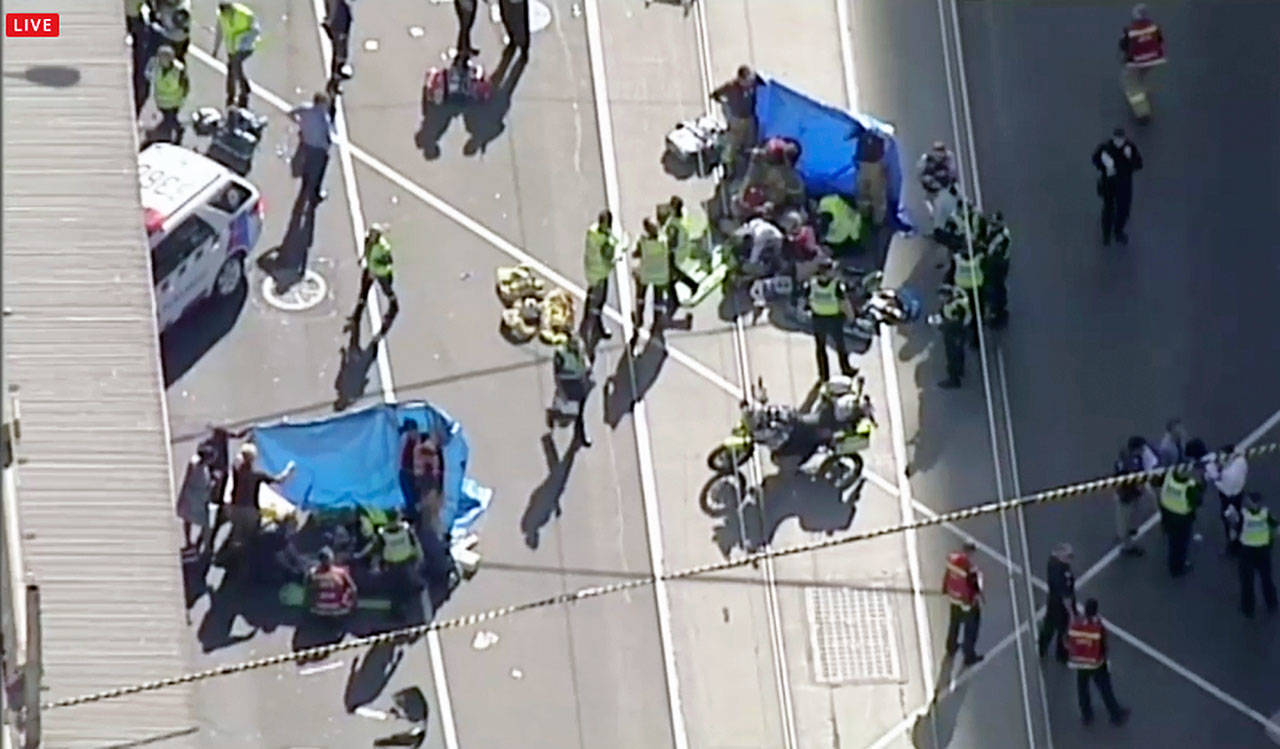By Tom Krisher and Lisa Marie Pane / Associated Press
A deadly attack this week in Melbourne, Australia, in which a man plowed an SUV into a crowd of Christmas shoppers comes from the same playbook used by terrorists in recent years around the globe. Many new vehicles rolling off car lots in the United States are equipped with technology that causes them to automatically stop if someone walks in their path. As more and more terrorists use vehicles to plow into crowds, the question has arisen in the auto industry: Can advances in technology thwart future attacks? And are there other ways to prevent the ubiquitous automobile from being used as a weapon?
What technological solutions exist?
Autonomous emergency braking systems automatically stop vehicles before a collision if a driver doesn’t react, though it’s not foolproof.
“For sure the technology is there to detect the pedestrians. The technology is there to automatically brake the vehicles,” Jeremy McClain, director of technology in North America for Continental Automotive Systems, said earlier this year.
Most systems now, including Continental’s, let the driver overrule the vehicle’s computer, largely because the systems have only a few camera or radar sensors and may pick up false signals.
Some systems will automatically stop a vehicle if the driver doesn’t, while others will slow it to mitigate crash damage. Already some are sophisticated enough to detect people who are walking. One version of Toyota’s safety system has sensors that will stop a car from moving in a parking lot if they detect something in its path, even if the driver accidentally hits the gas instead of the brake.
The systems are rapidly getting more accurate with laser sensors, and more powerful computers and artificial intelligence are being added as the industry rapidly moves toward self-driving cars. McClain said the cars could, in a relatively short time, be tasked with stopping drivers who have evil intent. “You’d have to consider all the circumstances, but you could definitely do it,” he said.
Continental has had early discussions with automakers about using the systems to stop terrorists, he said. But such a use is far into the future, and many automakers haven’t considered it yet.
What does the future hold?
Even when the technology is ready, it will take years for roughly 250 million older vehicles now on the road to be replaced with those equipped with the new technology. Only 19 percent of 2017 models have the technology as a standard feature, although four of 20 automakers say it’s now standard on more than half their models, according to the National Highway Traffic Safety Administration. Twenty companies have agreed to equip almost all of their vehicles with the feature by Sept. 1, 2022.
Toyota, which expects to have autonomous braking on all vehicles but a few in the U.S. by the end of this year, said it hasn’t discussed preventing terrorism yet. But a spokesman said the company always wants to stay ahead on safety.
The Alliance of Automobile Manufacturers, which represents a dozen major car manufacturers including General Motors, Ford and Toyota, said earlier this year the industry will consider anti-terrorist measures but would have to “carefully review all the ramifications to ensure that there aren’t some unintended trade-offs to road safety.”
What security experts say
The short answer is there’s no foolproof way to prevent these attacks. Cars are easy to obtain, easy to use and their safety systems can be overridden. Changes have been made to improve security around buildings or landmarks viewed as potential targets — embassies, for example — but those same steps aren’t always practical for roadways and sidewalks. It’s not only an expensive proposition but virtually impossible to make every place where a pedestrian might be safe.
“Society has to come to learn to accept the notion of total security, no matter who you are and where you live, doesn’t exist,” said Bruce Alexander, a terrorism and security expert based in Washington, D.C.
What else can be done?
Terror attacks in the past few decades have led to a number of changes in building design and other features, including the installation of bollards made to withstand ramming from vehicles.
Bollards notably ended a rampage in Times Square earlier this year by a driver who ran down 23 people. Because permanent barriers usually need to be anchored deeply, they aren’t generally installed on bridges, where two attacks in London occurred this year. Engineers are tackling that challenge with new synthetic materials that can withstand major impact without needing a deep anchor.
In New York and other large cities, police use SUVs to block roads and pedestrian walkways before events that are expected to draw large crowds, said Angela Hrdlicka, a former Secret Service agent who is now a private security consultant.
What are the challenges?
Vehicle attacks are considered “low-tech” terrorism, and the solutions are elusive. According to Colin P. Clarke and Louis Klarevas, who together wrote an article on the issue of car rammings earlier this year for The Atlantic, the reasons range from concerns about restricting people’s civil liberties to the expense of securing large numbers of public spaces. A more effective approach, they argue, is to use proactive measures designed to thwart would-be attackers, from surveillance ahead of large public events to a visible police presence.
Krisher reported from Detroit; Pane reported from Atlanta.
Talk to us
> Give us your news tips.
> Send us a letter to the editor.
> More Herald contact information.

























